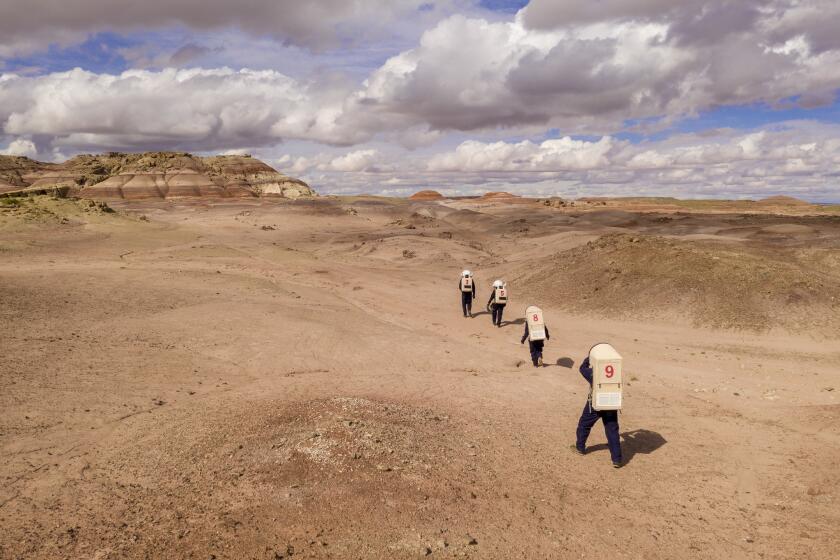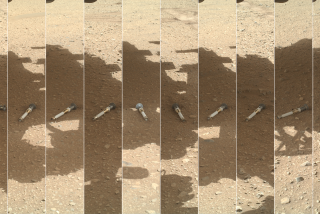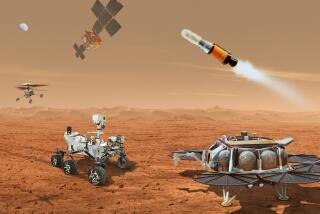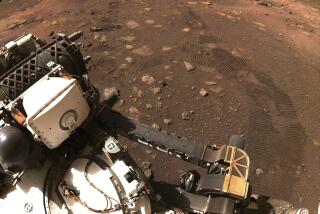NASA’s Perseverance rover ready to search for signs of ancient life on Mars
- Share via
If NASA’s Perseverance rover lands safely on the surface of Mars, it will mark several milestones in space exploration:
The first machine to harvest an essential human resource on another world.
The first to cache samples of a planet to one day be studied by scientists here on Earth.
And the first sent to directly search for signs of past extraterrestrial life.
NASA hasn’t saddled a spacecraft with such a monumental task since the 1970s, when the Viking mission was sent to the red planet to search for evidence of living microbes. That effort turned up more questions than answers.
Perseverance, NASA’s newest rover, completes its 7-minute descent and lands safely on Mars to begin a mission that will last at least one Martian year.
In the years since, the space agency has focused instead on intermediate, achievable objectives, such as finding signs of water or organic molecules that would be conducive to life. But Perseverance — the star of NASA’s Mars 2020 mission — is truly equipped to start tackling this existential mystery: Are we alone in the universe?
“This is the culmination of more than 50 years of Mars exploration,” said Briony Horgan, a Purdue University planetary geologist and Mars 2020 science team member. “We’re putting all of that data and all of that work we’ve done over decades to use, to try to really answer that question.”
Whether the answer is yes or no, the clues collected by the sample-stashing robot could help shape the future of space exploration.

Perseverance’s trip is a one-way ride that’s scheduled to end Thursday around 12:55 p.m. PST. Scientifically, however, it’s coming full circle from Viking 1 and 2, which reached Mars in 1976. The twin landers were sent with the express purpose of looking for evidence of life. They found intriguing chemical activity in the planet’s soil, but nothing conclusive.
“We didn’t understand enough about Mars to interpret that data,” Horgan said. “We still don’t really know entirely what Viking found.”
Subsequent missions took the scientific journey one step at a time. NASA returned to the Martian surface in 1997 with the tiny Sojourner rover. Next came the solar-powered twins Spirit and Opportunity, tasked with finding signs of past water on the planet’s surface. But water alone does not life make.
Curiosity landed on Mars in 2012 to search for chemical cocktails that, together with water, could provide hospitable environments for past life. Even that didn’t prove living things ever existed there.
With Perseverance, mission scientists at NASA’s Jet Propulsion Laboratory in La Cañada Flintridge and elsewhere are searching for hints of past life — a goal as ambitious as it is challenging.
Perseverance, NASA’s newest Mars rover, is living up to its name. It has already survived a hurdle no previous rover has had to face: a global pandemic.
Though Mars is dusty and dry today, scientists think it was warmer, wetter and altogether more Earthlike more than 3.5 billion years ago. Using its drill and lab instruments, Curiosity revealed that its home base of Gale Crater was once a watery place with the right organic ingredients to host life.
But finding signs of ancient life is far more difficult. It requires looking for the kinds of patterns left by living things on Earth. That means looking for certain structures and textures, not just the right raw materials.
“That’s how we actually build a case for biosignatures,” said JPL’s Kathryn Stack Morgan, the deputy project scientist for the $2.4-billion Mars 2020 mission. “That’s what we do on Earth.”
If there’s anywhere a rover should look for such biosignatures, it’s probably Jezero Crater. Located on the western edge of a flat plain just north of the Martian equator, the 28-mile-wide crater has all the hallmarks of a long-gone lake, including an ancient delta along one edge.
Deltas typically form when flowing water (from, say, a river) hits a body of water (such as a lake) and deposits clay minerals carried in from the surrounding area. Theoretically, if Martian microbes called Jezero home when the lake was filled, their remains would now be found in sediments in the lake bed or along the shoreline.
That’s why when scientists see the delta at Jezero Crater, they salivate. But when engineers see Jezero, they break into a sweat.
“It’s just a really dangerous landing site,” said Allen Chen, who leads the Mars 2020 entry, descent and landing team at JPL, where the rover was designed and built. There are fields of rocks and boulders, treacherous sand dunes and sharp cliffs. “There’s just hazards all over the place.”
For years, in fact, Jezero was too dangerous to even consider seriously. But innovations in landing technology changed that, Chen said.
Now, Perseverance will be armed with Range Trigger to calculate the spacecraft’s distance from its landing target and adjust the parachute’s opening time accordingly. There’s also Terrain-Relative Navigation, which allows the descending spacecraft to determine its location and choose the safest landing target it can reach.
These automated technologies are key, because Perseverance will need to make decisions on its own. Once at Mars, it takes more than 22 minutes for the spacecraft to send a message to its JPL handlers and receive a reply.
After the rover is safely on the ground, it will spend more than a month conducting system checks and preparing for the work ahead.
Weighing in at 2,260 pounds, stretching 10 feet in length, and wielding a powerful robotic arm, Perseverance looks like a heftier twin of Curiosity. But whereas Curiosity focused on studying Martian rocks using a suite of lab instruments in its belly, Perseverance sports a sophisticated system for collecting and stashing Martian samples that future spacecraft would pick up and return to Earth.
Perseverance also boasts an unparalleled collection of 23 onboard cameras. Atop its long neck sit Mastcam-Z, which can snap detailed close-ups of the minerals on the red planet’s surface. It’s joined by SuperCam, which combines a camera, laser and spectrometers to find rocks that formed or were transformed in Martian water.
Weather and dust sensors around the rover’s body will track ambient conditions, and a radar imager will examine geologic structures as much as 30 feet or more beneath its six wheels.
Both Curiosity and Perseverance have robotic arms, but the new rover features a far bigger “hand.” In its palm is PIXL, whose X-ray spectrometer will analyze chemical and textural changes in rocks and soil that could have been left by ancient microbial life. It shares space with SHERLOC, an ultraviolet spectrometer that, together with a camera named WATSON, will use an ultraviolet laser to peer at a rock’s mineralogy, pick up organic compounds and identify possible biosignatures.
Perseverance has some major upgrades compared to Curiosity, including tougher wheels to weather the unforgiving terrain. Self-driving software will allow it to cover more ground than its predecessor.
Then there’s Perseverance’s sidekick Ingenuity, the first helicopter designed to fly on another world.
Officials say the 4-pound helicopter may stay airborne for up to 90 seconds at a time, traveling close to 980 feet per flight at an altitude of 10 to 15 feet above the ground. (If that sounds humble, compare it to the 12-second first flight by the Wright Brothers.) Ingenuity could become the Sojourner of flying planetary missions, venturing a few momentous feet so that future, more science-oriented fliers might explore for miles.
Roving around Mars is so passe. So NASA is sending a helicopter to the red planet.
The rover will conduct a proof-of-concept experiment that’s crucial if humans are ever to set foot on Mars. MOXIE, the Mars Oxygen In-Situ Resource Utilization Experiment, will inhale the carbon dioxide that makes up roughly 96% of the Martian atmosphere and, rather like a tree, “exhale” oxygen that could be stored for human consumption or used to make propellant to fuel spacecraft on the red planet. If it works, it should produce oxygen at a rate of up to 0.022 pounds per hour.
And of course, while studying the Martian terrain, Perseverance will be caching pieces of the planet that future missions will ferry to Earth, where human geologists and their powerful laboratory instruments can study them in detail.
Even with all this effort, scientists may not find convincing evidence of Martian life. What then?
That result would still provide valuable information about what it takes for life to take root, Stack Morgan said.
“What is the special secret sauce that is needed to form life?” she said. “It may not just be a habitable environment — and I think that’s something for us to know and learn.”
For now, officials say they’re focused on the task in front of them: getting the rover safely onto the Martian surface. The roughly seven-minute entry, descent and landing sequence requires a flurry of carefully choreographed steps to slow the spacecraft from 12,500 miles per hour at the top of the atmosphere to just 1.7 mph shortly before touchdown.
Matt Wallace, the mission’s deputy project manager at JPL, is confident the team will keep its rover landing streak alive. Still, he said, he’ll sleep better after landing day.
“I’m looking forward to ... being able to stop waking up at 4 in the morning thinking about it,” he said. “So that’s exciting. And honestly, I’m really looking forward to seeing this mission do what it was designed to do.”








